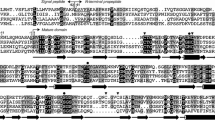Abstract
The optimal reaction conditions for the synthesis of γ-glutamylglutamine using γ-glutamyltranspeptidase from Escherichia coli were determined. The maximum yield of γ-glutamylglutamine (110 mM) was obtained using 250 mM l-glutamine and 1.1 U γ-glutamyltranspeptidase/ml at pH 10.5 and at 37°C for 7 h; the conversion of glutamine to γ-glutamylglutamine was 88%.






Similar content being viewed by others
References
Castell LM, Newsholme EA (1997) The effect of oral glutamine supplementation on athletes after prolonged, exhaustive exercise. Nutrition 13:738–742
Gandini C, De Lorenzi D, Kitsos M, Massolini G, Caccialanza G (1993) HPLC determination of pyroglutamic acid as a degradation product in parenteral amino acid formulations. Chromatographia 36:75–78
Hara T, Yokoo Y, Furukawa T (1992) Potential of γ-glutamyl-l-cystine and bis-γ-l-glutamyl-l-cystine as a cystine-containing peptide for parental nutrition. In: Takai K (ed) Frontiers and new horizons in amino acid research. Elsevier, Amsterdam, pp 607–611
Houndijk AP, Rijnsburger ER, Jansen J, Wesdorp RI, Weiss JK, McCamish MA, Teerlink T, Meuwissen SG, Haarman HJ, Thijs LG, Van Leeuwen PA (1998) Randomised trial of glutamine-enriched enteral nutrition on infectious morbidity in patients with multiple trauma. Lancet 352:772–776
Inoue M, Hiratake J, Suzuki H, Kumagai H, Sakata K (2000) Identification of catalytic nucleophile of Escherichia coli γ-glutamyltranspeptidase by γ-monofluorophosphono derivative of glutamic acid: N-terminal Thr-391 in small subunit is the nucleophile. Biochemistry 39:7764–7771
Lacey JM, Wilmore MD (1990) Is glutamine a conditionally essential amino acid? Nutr Rev 48:297–309
Shih FF (1985) Analysis of glutamine, glutamic acid and pyroglutamic acid in protein hydrolysates by high performance liquid chromatography. J Chromatogr 322:248–256
Suzuki H, Kumagai H, Tocikura T (1986a) γ-Glutamyltranspeptidase from Escherichia coli K-12: purification and properties. J Bacteriol 168:1325–1331
Suzuki H, Kumagai H, Tochikura T (1986b) γ-Glutamyltranspeptidase from Escherichia coli K-12: formation and localization. J Bacteriol 168:1332–1335
Suzuki H, Izuka S, Miyakawa N, Kumagai H (2002a) Enzymatic production of theanine, an “umami” component of tea, from glutamine and ethylamine with bacterial γ-glutamyltranspeptidase. Enzyme Microb Technol 31:884–889
Suzuki H, Kajimoto Y, Kumagai H (2002b) Improvement of the bitter taste of amino acids through the transpeptidation reaction of bacterial γ-glutamyltranspeptidase. J Agric Food Chem 50:313–318
Suzuki H, Izuka S, Minami H, Miyakawa N, Ishihara S, Kumagai H (2003) Use of bacterial γ-glutamyltranspeptidase for enzymatic synthesis of γ-d-glutamyl compounds. Appl Environ Microbiol 69:6399–6404
Thomas S, Balasubramanian KA (2003) Oral glutamine attenuates surgical manipulation-induced alterations in the intestinal brush border membrane. J Surg Res 115:148–156
Yamada C, Kijima K, Ishihara S, Miwa C, Wada K, Okada T, Fukuyama K, Kumagai H, Suzuki H (2008) Improvement of the glutaryl-7-aminocephalosporanic acid acylase activity of a bacterial γ-glutamyltranspeptidase. Appl Environ Microbiol 74:3400–3409
Acknowledgements
We would like to thank Dr. Bunnta Watanabe and Prof. Jun Hiratake, Institute for Chemical Research, Kyoto University, for the NMR and MS analyses and for their productive discussion. This work was supported by a Grant-in-Aid for Scientific Research (no. 21380059) to HS from the Ministry of Education, Culture, Sports, Science and Technology of Japan. CY was supported by the 21st Century COE Program of the Ministry of Education, Culture, Sports, Science and Technology of Japan.
Author information
Authors and Affiliations
Corresponding author
Additional information
All amino acids and peptides were used in this study were l-isomers.
Purpose of work: Glutamine has favorable effects on humans but is unstable in aqueous solution and easily forms pyroglutamic acid. γ-Glutamylglutamine is more stable than glutamine and is almost as stable as alanylglutamine. Moreover, the taste of γ-glutamylglutamine is preferable to that of alanylglutamine. Therefore, γ-glutamylglutamine is a promising candidate for use as a glutamine precursor in food additives.
Rights and permissions
About this article
Cite this article
Sayed, A.S.A.F.E., Fujimoto, S., Yamada, C. et al. Enzymatic synthesis of γ-glutamylglutamine, a stable glutamine analogue, by γ-glutamyltranspeptidase from Escherichia coli K-12. Biotechnol Lett 32, 1877–1881 (2010). https://doi.org/10.1007/s10529-010-0364-z
Received:
Accepted:
Published:
Issue Date:
DOI: https://doi.org/10.1007/s10529-010-0364-z




